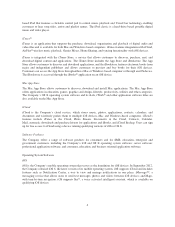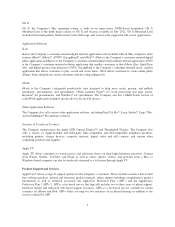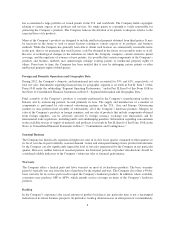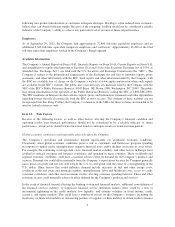Apple 2012 Annual Report Download - page 13
Download and view the complete annual report
Please find page 13 of the 2012 Apple annual report below. You can navigate through the pages in the report by either clicking on the pages listed below, or by using the keyword search tool below to find specific information within the annual report.global economic conditions on the Company’s suppliers, described in “Global economic conditions could
materially adversely affect the Company” above, also could affect the Company’s ability to obtain components.
Therefore, the Company remains subject to significant risks of supply shortages and price increases. The
Company expects to experience decreases in its gross margin percentage in future periods, as compared to levels
achieved during 2012, largely due to a higher mix of new and innovative products with flat or reduced pricing
that have higher cost structures and deliver greater value to customers and anticipated component cost and other
cost increases. Future strengthening of the U.S. dollar could also negatively impact gross margin.
The Company and other participants in the markets for mobile communication and media devices and personal
computers also compete for various components with other industries that have experienced increased demand
for their products. The Company uses some custom components that are not common to the rest of these
industries. The Company’s new products often utilize custom components available from only one source. When
a component or product uses new technologies, initial capacity constraints may exist until the suppliers’ yields
have matured or manufacturing capacity has increased. Continued availability of these components at acceptable
prices, or at all, may be affected if those suppliers decided to concentrate on the production of common
components instead of components customized to meet the Company’s requirements. The supply of components
for a new or existing product could be delayed or constrained, or a key manufacturing vendor could delay
shipments of completed products to the Company.
The Company depends on component and product manufacturing and logistical services provided by outsourcing
partners, many of whom are located outside of the U.S.
Substantially all of the Company’s manufacturing is performed in whole or in part by a few outsourcing partners
located primarily in Asia. The Company has also outsourced much of its transportation and logistics
management. While these arrangements may lower operating costs, they also reduce the Company’s direct
control over production and distribution. It is uncertain what effect such diminished control will have on the
quality or quantity of products or services, or the Company’s flexibility to respond to changing conditions.
Although arrangements with these partners may contain provisions for warranty expense reimbursement, the
Company may remain responsible to the consumer for warranty service in the event of product defects and could
experience an unanticipated product defect or warranty liability. While the Company relies on its partners to
adhere to its supplier code of conduct, material violations of the supplier code of conduct could occur.
The supply and manufacture of many critical components is performed by sole-sourced outsourcing partners in
the U.S., Asia and Europe. Outsourcing partners in Asia perform final assembly of substantially all of the
Company’s hardware products. Manufacturing or logistics in these locations or transit to final destinations may
be disrupted for a variety of reasons including, but not limited to, natural and man-made disasters, information
technology system failures, military actions or economic, business, labor, environmental, public health, or
political issues.
The Company relies on third-party intellectual property and digital content, which may not be available to the
Company on commercially reasonable terms or at all.
Many of the Company’s products include third-party intellectual property, which requires licenses from those
third parties. Based on past experience and industry practice, the Company believes such licenses generally can
be obtained on reasonable terms. There is, however, no assurance that the necessary licenses can be obtained on
acceptable terms or at all.
The Company also contracts with third parties to offer their digital content through the iTunes Store. The
licensing arrangements with these third parties are short-term and do not guarantee the continuation or renewal of
these arrangements on reasonable terms, if at all. Some third-party content providers and distributors currently or
in the future may offer competing products and services, and could take action to make it more difficult or
impossible for the Company to license their content in the future. Other content owners, providers or distributors
12
























